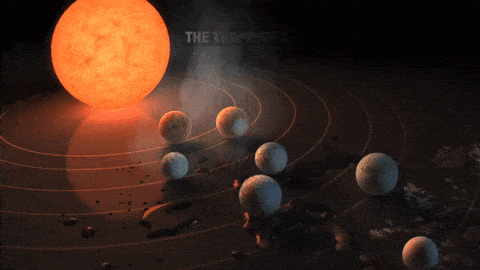
Star Formation
Quiz
•
Science
•
9th - 12th Grade
•
Practice Problem
•
Medium
+3
Standards-aligned

Clint Sandford
Used 313+ times
FREE Resource
Enhance your content in a minute
20 questions
Show all answers
1.
MULTIPLE CHOICE QUESTION
45 sec • 1 pt

Vast areas filled with very cold gas & dust between stars is known as
one big empty area in space.
"cosmic fluff."
the interstellar medium.
the interstellar void.
2.
MULTIPLE CHOICE QUESTION
1 min • 1 pt

How did the gas & dust between the stars & in all corners of the Universe get there?
the result of planetary collisions & explosions
by the gravitational attraction of supermassive black holes
the Big Bang created it all
the result of leftover remnants of previous stars
Tags
NGSS.HS-ESS1-2
3.
MULTIPLE SELECT QUESTION
1 min • 1 pt

Some examples of the interstellar medium (or "nebula") clouds include
areas in the Small & Large Magellanic clouds (SMC & LMC).
the Orion nebula.
the Horcrux nebula.
Sagittarius "A" (SGR A*).
4.
MULTIPLE CHOICE QUESTION
1 min • 1 pt

The interstellar medium & nebula clouds are important because
the Big Bang would've never occurred without them.
black holes would never exist if the clouds were not there.
they make up the space between the stars.
they are regions for new star formation.
5.
MULTIPLE CHOICE QUESTION
1 min • 1 pt

What causes the interstellar clouds to collapse to form proto-stars & stars?
centripetal forces that act over large areas between stars
a contraction & clumping of gas/dust due to gravity
a contraction & clumping of gas/dust due to frictional force
a "trigger" mechanism such as two colliding stars
Tags
NGSS.MS-ESS1-2
NGSS.MS-PS2-4
6.
MULTIPLE CHOICE QUESTION
1 min • 1 pt

Eventually a "snowball effect" occurs in a contracting gas/dust cloud which causes
material to slowly build up into one or more proto-stars.
a cascading avalanche of star material spreading everywhere.
massive clumps of ice/snow to form.
a net effect of negatively charged explosive plasma/ions.
Tags
NGSS.MS-ESS1-2
7.
MULTIPLE CHOICE QUESTION
45 sec • 1 pt

Proto-stars are also known as ____ for the constellation in which the first one was observed.
neutron stars
very hot fusion orbs
T Tauri stars
A Tari stars.
Tags
NGSS.HS-ESS1-1
NGSS.HS-ESS1-3
Create a free account and access millions of resources
Create resources
Host any resource
Get auto-graded reports

Continue with Google

Continue with Email

Continue with Classlink

Continue with Clever
or continue with

Microsoft
%20(1).png)
Apple
Others
By signing up, you agree to our Terms of Service & Privacy Policy
Already have an account?
Similar Resources on Wayground

15 questions
Grade 9: Electricity Revision 2
Quiz
•
9th Grade

20 questions
IS_Section Quiz_14.6–14.7_e
Quiz
•
9th Grade

20 questions
Scalars and Vectors | Physics - 12th Grade
Quiz
•
12th Grade

15 questions
Icebreaker - Geological & Hydrometeorological Hazards Quiz
Quiz
•
11th - 12th Grade

15 questions
Reflection of light
Quiz
•
10th Grade

19 questions
Waves
Quiz
•
9th Grade

16 questions
Geology Rocks
Quiz
•
9th Grade

20 questions
Grade 9 Pressure
Quiz
•
9th Grade
Popular Resources on Wayground

10 questions
Honoring the Significance of Veterans Day
Interactive video
•
6th - 10th Grade

9 questions
FOREST Community of Caring
Lesson
•
1st - 5th Grade

10 questions
Exploring Veterans Day: Facts and Celebrations for Kids
Interactive video
•
6th - 10th Grade

19 questions
Veterans Day
Quiz
•
5th Grade

14 questions
General Technology Use Quiz
Quiz
•
8th Grade

25 questions
Multiplication Facts
Quiz
•
5th Grade

15 questions
Circuits, Light Energy, and Forces
Quiz
•
5th Grade

19 questions
Thanksgiving Trivia
Quiz
•
6th Grade
Discover more resources for Science

10 questions
Exploring Newton's Laws of Motion
Interactive video
•
6th - 10th Grade

10 questions
Unit 2: LS.Bio.1.5-LS.Bio.2.2 Power Vocab
Quiz
•
9th - 12th Grade

10 questions
Exploring Light and Waves Concepts
Interactive video
•
6th - 10th Grade

12 questions
Endothermic and Exothermic Reactions
Quiz
•
7th - 10th Grade

20 questions
Balanced and unbalanced forces
Quiz
•
10th Grade

10 questions
Exploring Thermal Energy and Temperature Concepts
Interactive video
•
6th - 10th Grade

10 questions
Exploring Kinetic and Potential Energy Concepts
Interactive video
•
6th - 10th Grade

32 questions
Explore Mixtures and Solutions
Quiz
•
9th - 12th Grade



